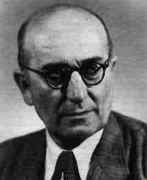Person: Čech, Eduard

Eduard Čech was a Czech mathematician known for his work in projective differential geometry and topology. He introduced the idea of the higher homotopy groups of a space.
Mathematical Profile (Excerpt):
- Already Čech was studying mathematical texts which were much more advanced than the level of his courses and he spent much time in the Mathematics library.
- Čech spent three years in the army, but they were not totally wasted as far as his academic studies were concerned for he took the opportunity to learn Italian, German and Russian.
- Having obtained his degree, Čech began to teach in secondary schools in Prague but he continued to undertake research in mathematics and completed his doctorate in 1920.
- Čech studied there between 1921 and 1922 and he clearly impressed Fubini who asked him to cooperate with him in joint project to write a monograph on projective differential geometry.
- After leaving Italy in 1922, Čech wrote his habilitation thesis, becoming a docent at the Charles University of Prague.
- This post did not carry a salary, so Čech continued to teach in the secondary schools of Prague to earn enough money to live.
- However, Lerch died in 1922 and the opportunity arose for Čech to gain a chair and a permanent university post.
- Čech was appointed extraordinary professor at Masaryk University in 1923.
- Čech was interested in geometry but he was appointed to the chair of analysis at Masaryk University since this had been Lerch's chair.
- Although geometry was Čech's field of research, Čech had to take over courses in analysis and algebra.
- Through his widening mathematical interests, to some extent forced on him by his teaching duties, Čech became interested in topology, in particular he became one of the foremost experts on combinatorial topology.
- In this paper, which introduces the topic which today is called the Čech homology theory, Čech also introduced the notion of the inverse limit.
- At the International Congress of Mathematicians in Zürich in 1932, Čech introduced the notion of higher homotopy groups of a space.
- Two years later Čech extended his work on homology to local homology.
- On hearing Čech talk about his results at a combinatorial topology conference in Moscow, Lefschetz invited him to visit Princeton and Čech made the visit during session 1935-36.
- Čech was influenced by the work of Aleksandrov and Urysohn and he set up a topology seminar at Brno in 1936 which went on to produce 26 papers in 3 years.
- One of these papers was Čech's paper On bicompact spaces (1937) which introduced what today is called the Stone-Čech compactification of regular topological spaces.
- Čech's Brno seminar only ended when the Czech universities were closed down at the start of World War II.
- Čech, however, tried to continue the work of his seminar despite the War and it continued to meet at the flat of B Pospisl, one of his students, until 1941.
- Before the start of the war Čech had begun to organise courses for school teachers in Brno.
- Čech became Director of the Mathematical Research Institute of the Czech Academy of Sciences in 1947, Director of the Central Mathematical Institute in 1950, and Director of the Czech Academy in 1952.
- Let us end this biography by giving some details of Čech's character.
Born 29 June 1893, Stracov, Bohemia (now Czech Republic). Died 15 March 1960, Prague, Czechoslovakia (now Czech Republic).
View full biography at MacTutor
Tags relevant for this person:
Origin Czech Republic, Topology
Thank you to the contributors under CC BY-SA 4.0! 

- Github:
-

- non-Github:
- @J-J-O'Connor
- @E-F-Robertson
References
Adapted from other CC BY-SA 4.0 Sources:
- O’Connor, John J; Robertson, Edmund F: MacTutor History of Mathematics Archive
